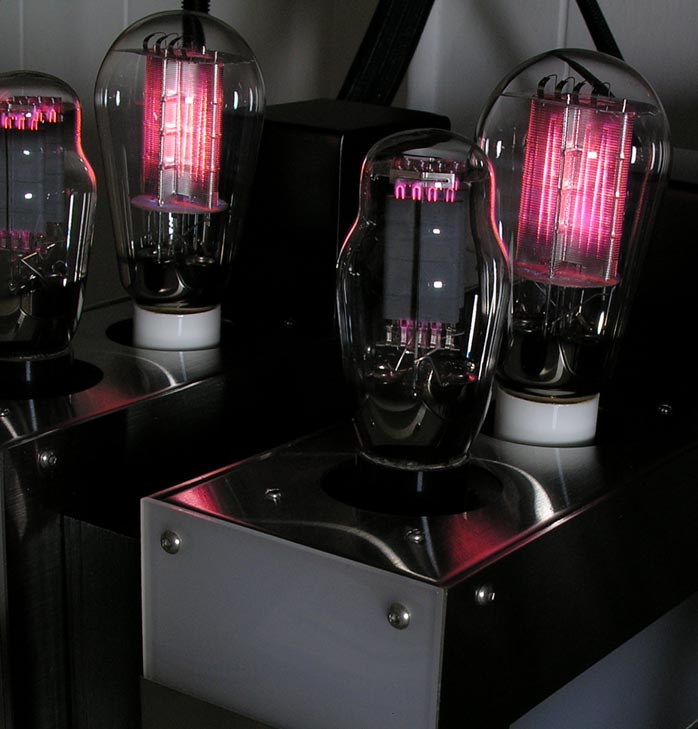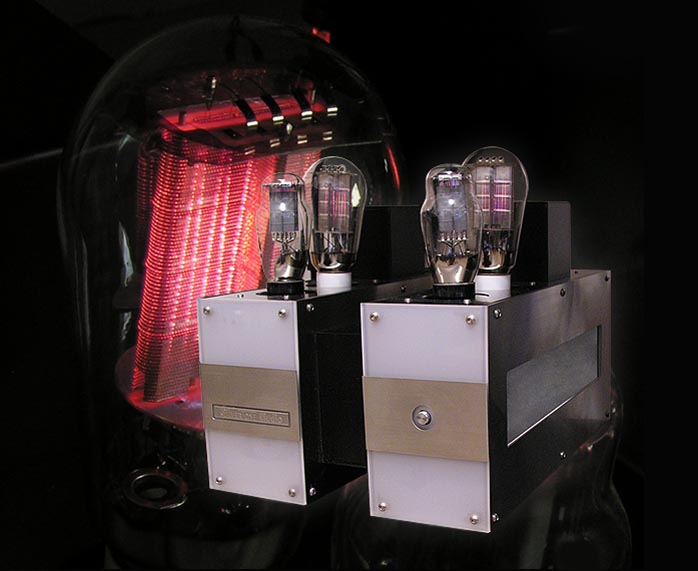|
This review page is supported in part by the sponsor whose ad is displayed above
|
||||||||
 |
||||||||
| As this is indeed intended as a brief follow-up report on the SilverTone Model 3.2 300B amplifier, I'll direct the reader to Srajan's extensive review for much greater detail on the inner workings of this dual-mono amplifier. However there are a couple of key facts that bear reiteration. First, the 3.2 is indeed a dual-mono stereo amplifier with zero NFB. SilverTone's choice of chassis design would seem to demonstrate SilverTone's strides to emphasize that point as, while coupled in the middle like conjoined twins, each half of the stereo amplifier has earned its own chassis. Also, great effort has been made to cut the amplifier's self-noise through the use of a power transformer with a noise-reducing electrostatic shield placed between the primary and secondary windings and two huge air-gapped silicon-steel-core anode chokes for the 300Bs. More on this anon. |
||||||||
 |
||||||||
| The SilverTone Model 3.2 produces 8 watts of SET power from a pair of Sovtek 5U4G rectifiers, a pair of EH6C45pi and a pair of gold-pin mesh plate Full Music 300Bs. Catalano tells me that the SilverTone was designed and voiced around the Full Music 300B tube and when I wrote him about the possibility of introducing the self-biasing 3.2s to a pair of expensive Western Electric 300Bs, he discouraged the idea preferring me to stick with the stock tubes. There were three reasons I didn't press the issue. First, the Full Music mesh plate tubes sound great. Second, I love the subtle glow they emit in a darkened room. Third, as this is a follow-up intended to describe the results of the 3.2's recent revoicing, it only made sense to keep it stock in order to ensure a comparison of apples to apples. Lastly, this is one heavy amplifier when one considers its power output. Weighing in at 73 pounds, it weighs more than the Perikles loudspeakers. If I had one nit to pick about the amplifier, it would relate to four of the shortest feet I've ever encountered used in conjunction with a very heavy amplifier. It makes getting fingers under the chassis in order to move it very difficult. For purposes of making this amplifier easier to move around, it really needs taller feet. One change since Srajan wrote his review a year ago affects both the sales price of the 3.2 as well as the sales venue. Exchange rates and dealer margins being what they are, to sell the SilverTone through a dealer network, moving pricing somewhere in the vicinity of $6,000 would be required. To keep the amplifier the value that it was a year ago, it was determined that it would instead be sold direct for $4,500. |
||||||||
 |
||||||||
Moving on, upon receipt of the SilverTone I decided to introduce it to a fairly unlikely partner, my pair of 88dB efficient Tidal Piano loudspeakers, which happened to be set up in the listening room. Eight watts and 88dB of efficiency promised a short and less than romantic tryst but introducing the two to each other I did. Imagine my shock when they seemed to carry on famously as they proceeded to dance and make beautiful if macro-dynamically restricted music well into the night. Alas, morning came and as we all knew it was not meant to be, the Tidals bid the SilverTones a fond farewell. This was an arranged rendezvous after all and really had the name Hørning signed at the bottom. Nevertheless, the Pianos took their exit in stride with a fond remembrance of the exceedingly neutral and flattering personality of the SilverTone that allowed them to sing with singular independence. |
||||||||
 |
||||||||
Fortunately and as predicted, the short-term dalliance with the Tidals, while enjoyable, was to give way to a much more meaningful and mutually respectful rapport with the much more efficient Hørning Perikles. The first thing I noticed was the result of SilverTone's efforts to subdue noise from the 3.2. The 3.2 was dead quiet into the 96dB efficient Hørnings. With my ear to the speaker, I heard nothing. Zip, nada. I'm not sure I've ever experienced this degree of silence before with the Hørnings, even with solid-state amplification. Once the music commenced, I was equally impressed by the velvety smoothness of their presentation. In three words, I'd describe it as neutral, neutral and neutral, quite possibly the most colorless and tasteless amplifier I've ever evaluated and the closest to the ideal of a straight wire with gain. I'd already observed this when used in conjunction with the Tidals and now with the Hørnings I was hearing a -- here comes that word again -- velvety smoothness that while not subjectively or overtly warm, was anything but bright. There's not even the slightest hint of elevation through the midrange lending an added sparkle to the music. If I've ever heard an amplifier that came forth with the straightforward, unadorned and God's honest truth, it'd be the 3.2. If you're looking for the SilverTone to bring something, anything, to your system, it had better be honesty. If you're looking for sweetening, it had better be because your current amplifier is strident or bright. If you're looking for warmth, it had better be because your amplifier is cold. Tonally, all the SilverTone can bring to the table is transparency and candor. And grain-free smoothness. Srajan observed a plump bottom end on the 3.2 that was intentionally designed into the amplifier to make it a more copasetic match with single-driver speaker systems, many of which could use some added warmth, muscle and presence down there. Well, that's gone now. There's neither a mountain nor a mole hill of bass assistance to be found. However, that's not to say the SilverTone is a lesser mate to such speakers today. While it's decidedly honest through the bass, the 3.2's linearity and smoothness would make it an excellent mate not only for a pair of speakers completely lacking that Lowther-shout like the Hørnings but to a speaker like the Third Rethms as well. While the SilverTone isn't colored or subtractive through the upper midrange, it sure won't do anything to exacerbate any problems either. And its honesty will prevent its obsolescence should you change its dance partner at some point down the road - as long as they don't hunger for more than the eight watts the SilverTone serves up. |
||||||||
 |
||||||||
Comparison to its former self aside, I'll say that I was mightily impressed with this SilverTone amplifier. While it exaggerates nothing, it's got all that 300B transparency and intimacy that one turns to this exalted triode for. Speed and agility are also givens. As compared to the Canary CA 330s -- a pair of monos featuring dual 300Bs on each side for 26 push-pull watts per side and which retail for twice the price of the SilverTone while arriving sans output tubes -- there were some very real differences but overall, the amps had a great deal in common. First, the more powerful Canarys do push bass in a way that the SilverTones can't. In fact, this is one thing I'm noticing that the Canary amplifiers do exceedingly well in comparison with most of the competition - bass. Second, once one acclimates to the neutral nature of the SilverTone amp, the Canarys are a little more illuminated through the upper midrange. The Canarys present a little more energy on strings and brass and with a little added sparkle and flare. When used in conjunction with the Hørnings, there was no question that the SilverTone combined for a more neutral final product and it would be my choice for most single-driver systems with which I'm familiar. As compared to my Art Audio Carissa, an 845 SET amplifier producing twice the SilverTone's eight watts, the exact same things can be said. The Carissa adds more life towards the top and more power down below. Both amps offer up a crystal-clear midrange but, by a small margin, it is the SilverTone that seems a little more refined and musically natural. That's no slam on the Carissa, either. It's an exceptional amplifier as well. It just offers up its own view on reality in an attempt to compliment a different kind of system, hopefully for the same neutral final outcome. |
||||||||
 |
||||||||
The SilverTone 3.2 amplifier appears to be an exceptionally well-designed and executed product. From its absent noise floor through its ultra-smooth and neutral tonal balance to its transparent and immediate overall character, I can't imagine it not fitting well with any basically neutral system whose speaker appetite doesn't exceed its eight watts of power. But particularly if you're looking for something outstandingly well suited to a single driver loudspeaker, I just don't see any reason to look further than the SilverTone. It's a great little amp! As for the mating between the Hørning speakers and the SilverTone amplifier, I have to credit Jeffrey Catalano for an excellent ear and either a lot of perseverance or a tremendous amount of luck. When he stumbled upon both of these brands, he stumbled upon a marriage made in heaven, so strong is their combined synergism. I highly recommend both the Hørnings and the SilverTones individually but if you're considering one, you owe it to yourself to consider the other as well. When combined as a system, there's some real magic happening here. |
||||||||
 |
||||||||
 |
||||||||
 |
||||||||